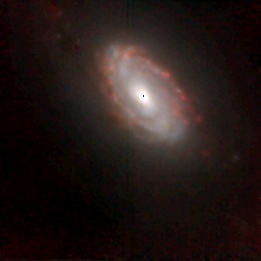Top Qs
Timeline
Chat
Perspective
NGC 23
Galaxy in the constellation Pegasus From Wikipedia, the free encyclopedia
Remove ads
NGC 23 is a spiral galaxy located in the northern constellation of Pegasus, around 173.5 megalight-years distant from the Milky Way.[3] It was discovered by William Herschel on 10 September 1784.[6][7] In the Webb Society Deep-Sky Observer's Handbook,[8] the visual appearance of NGC 23 is described as follows:
Bright, extended ellipse; a bright nuclear structure is noticeably elongated; two weak spiral enhancements emerge from opposite sides of the nucleus, one curving towards a bright star attached on the south end. The galaxy is likely interacting with NGC 9.
The shape of this galaxy is described by its morphological classification of SBb, which indicates it is a barred spiral (SB) with spiral arms that are moderately tightly wound (b).[4] It is a luminous infrared galaxy with star-forming clumps.[9]
Remove ads
NGC 23 group
NGC 23 is part of the NGC 23 group (also known as LGG 2) that includes at least 6 other galaxies: NGC 1, NGC 26, UGC 69, UGC 79, UGC 110, and UGC 127.[10]
Supernova
One supernova has been observed in NGC 23. SN 1955C (type unknown, mag. 16) was discovered by Allan Sandage in September 1958 using the Hale Telescope. On a photographic plate taken 23 October 1955 (three years prior), a bright star with a visual magnitude around 16 was located 10″ to the north and 10″ east of the galactic center. The star was not visible on a photograph taken 60 days prior.[11][12]
Remove ads
See also
References
External links
Wikiwand - on
Seamless Wikipedia browsing. On steroids.
Remove ads

